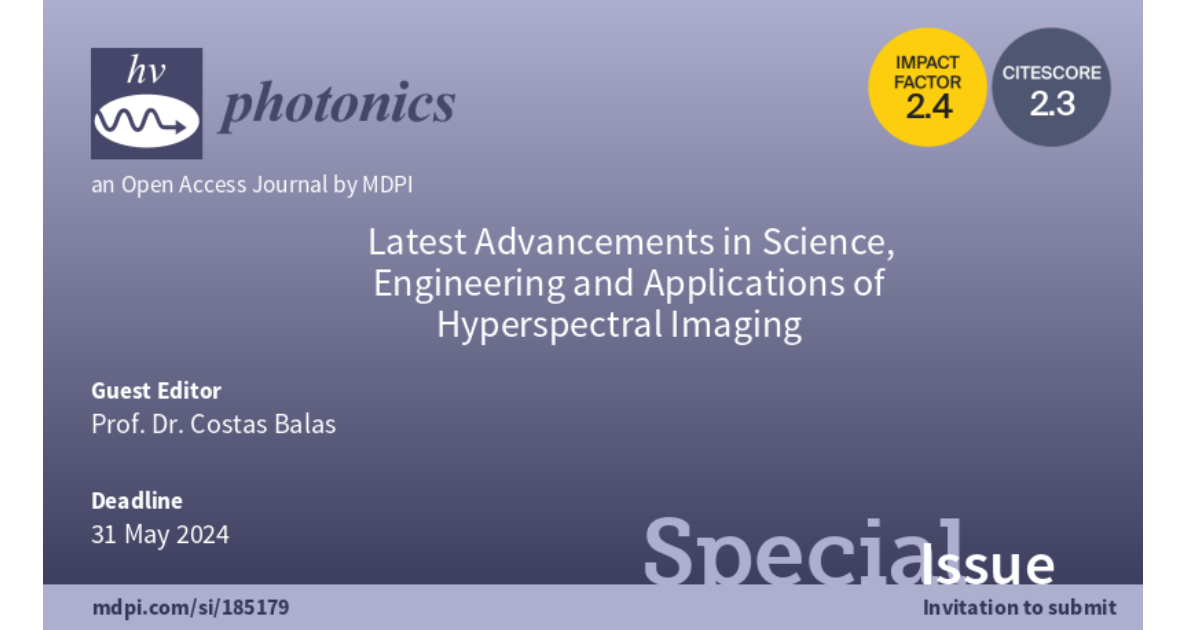- 1.9Impact Factor
- 3.5CiteScore
- 15 daysTime to First Decision
Latest Advancements in Science, Engineering and Applications of Hyperspectral Imaging
Special Issue Information
Dear Colleagues,
Hyperspectral imaging has been established as a powerful technology for remote sensing, non-destructive analysis and non-invasive diagnosis because it combines the advantages of both imaging and spectroscopy (high spatial and spectral resolution) in a single instrument; however, its full potential is yet to be explored and exploited. Hyperspectral imaging generates a pack of narrow-band images, constituting the so-called spectral cube or hypercube. Each pixel in the spectral cube, therefore, represents the spectrum of the scene at that point. Hyperspectral imaging is the technology of choice when heterogeneous objects are being examined with the purpose of gathering compositional information on a point-by-point basis.
A wealth of new research has been conducted and published in recent years, which has remarkably advanced the entire acquisition–analysis–visualization–application pipeline. Important new developments in data acquisition hardware include more efficient tunable filter designs and new concepts for snapshot or zero-scanning-time devices, such as pixelated sensors, metasurface/metalens-based sensors, coded aperture and compressive sampling camera system designs.
In the hypercube data analysis domain, the development of novel, more efficient algorithms for addressing the ill-posed problem of dimensionality expansion, data dimensionality reduction and critical band(s) selection, image classification and fusion, and comprehensive spectral cube representation have further improved our ability to retrieve critical information from the scene in demanding applications.
Hyperspectral imaging has benefited greatly from the recent breakthroughs in a plurality of diverse scientific and engineering fields, as they have played a critical role in minimizing the traditional trade-offs between spatial, spectral and temporal information. Another important interdisciplinary development is the integration of machine learning/AI platforms with advanced portable imagers in a unified system, providing analytical or diagnostic mapping, even in real-time and in situ scenarios. Smart, fast and miniaturized/portable systems may be considered as the new hyperspectral imaging technology generation, with great potential to break barriers to entry in a variety of new fields, such us clinical medicine, monitoring dynamic effects in both laboratory and industrial settings, robotic/machine vision, moving target identification and consumer camera/mobile phone photography.
This Special Issue invites submissions of original research articles as well as reviews pertaining to the following aspects of hyperspectral imaging (the list of topics is not exhaustive):
- Novel spectral imaging sensor and camera designs;
- Advanced, multimodal (hybrid) imaging systems combining spectral imaging and other imaging modalities;
- Miniaturized spectral imagers;
- Computational imaging-based spectral imagers;
- Video-rate spectral imagers;
- Unsupervised classification of spectral imaging data;
- Machine learning and AI methods applied to spectral imaging;
- Applications of spectral imaging in (indicatively) remote sensing, spectral phenotyping, food quality assessment, art conservation, microscopy, endoscopy, surgery, forensics, robotics, on-line inspection, etc.
Prof. Dr. Costas Balas
Guest Editor
Manuscript Submission Information
Manuscripts should be submitted online at www.mdpi.com by registering and logging in to this website. Once you are registered, click here to go to the submission form. Manuscripts can be submitted until the deadline. All submissions that pass pre-check are peer-reviewed. Accepted papers will be published continuously in the journal (as soon as accepted) and will be listed together on the special issue website. Research articles, review articles as well as short communications are invited. For planned papers, a title and short abstract (about 250 words) can be sent to the Editorial Office for assessment.
Submitted manuscripts should not have been published previously, nor be under consideration for publication elsewhere (except conference proceedings papers). All manuscripts are thoroughly refereed through a single-blind peer-review process. A guide for authors and other relevant information for submission of manuscripts is available on the Instructions for Authors page. Photonics is an international peer-reviewed open access monthly journal published by MDPI.
Please visit the Instructions for Authors page before submitting a manuscript. The Article Processing Charge (APC) for publication in this open access journal is 2400 CHF (Swiss Francs). Submitted papers should be well formatted and use good English. Authors may use MDPI's English editing service prior to publication or during author revisions.
Keywords
- scanning
- snapshot
- compact
- video-rate (hyper-) spectral imagers
- supervised and unsupervised spectral cube data classifiers
- dimensionality reduction/expansion of spectral cube data
- (hyper-) spectral imaging-based monitoring/inspection
- artificial vision
- medical diagnosis
- material identification
- nondestructive analysis

Benefits of Publishing in a Special Issue
- Ease of navigation: Grouping papers by topic helps scholars navigate broad scope journals more efficiently.
- Greater discoverability: Special Issues support the reach and impact of scientific research. Articles in Special Issues are more discoverable and cited more frequently.
- Expansion of research network: Special Issues facilitate connections among authors, fostering scientific collaborations.
- External promotion: Articles in Special Issues are often promoted through the journal's social media, increasing their visibility.
- e-Book format: Special Issues with more than 10 articles can be published as dedicated e-books, ensuring wide and rapid dissemination.

